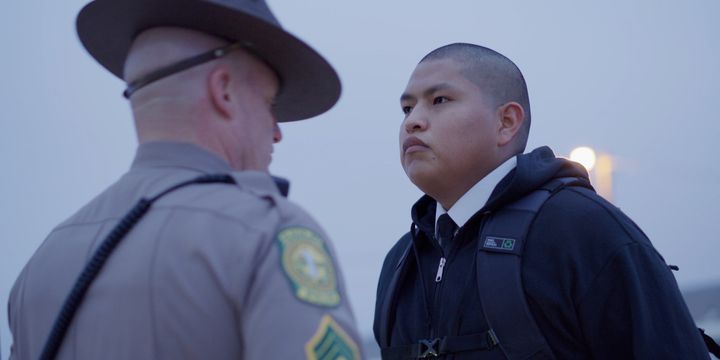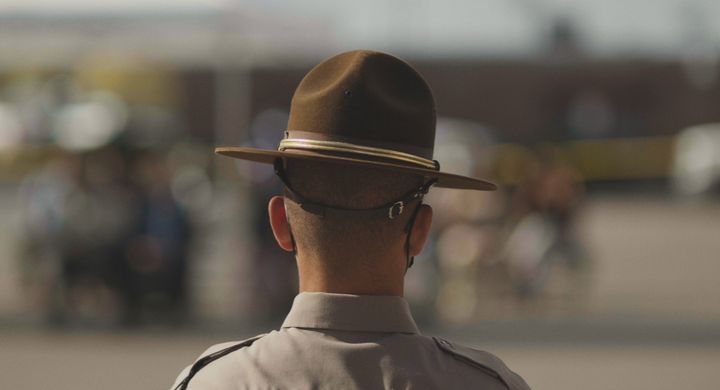The Navajo Police Department is the only tribal law enforcement agency in the country that trains its own officers. The department’s mandate to protect is both a covenant with their culture and an oath to the law.
The task of finding young Navajo to take up the badge is explored in sharp detail in the new Max docuseries, “Navajo Police: Class 57,” co-directed by Kahlil Hudson, Alex Jablonski and David Nordstrom.
Navajo Nation spans 17.5 million acres, but only has 180 police officers to serve their people. Though the department estimates that the nation’s 170,000-plus residents need 500 officers, it struggles to find recruits who can fully serve the Diné, the Navajo word for their own people.
While “duty” is a word often invoked by police, it takes on a different tone in Navajo territory, which is guided by the concept “k’é,” or a sense of kinship and mutual responsibility for Diné lives, culture and history.
“We’re taught at a young age that everyone is your relative, and to have kinship and k’é,” activist Shandiin Yazzie explains in the series. “It’s like going up to a random stranger and being willing to help, because k’é means you have a responsibility to one another.”

In practice, those deep personal connections can make policing in tribal land extremely complicated.
Navajo cadets must learn how to balance being “not only a warrior, but also a marriage counselor or a therapist or a shoulder to cry on, or a sort of social worker,” Nordstrom explained to HuffPost in an exclusive interview.
Often having endured the same sort of generational trauma as the people they patrol, Navajo police officers seem to feel a wedge between protecting their communities and perpetuating the kind of violence that has devastated Diné. That thorny history also means it’s not rare to find the Navajo Police Department responding to, or even arresting, members of their own family.
The urge to break those patterns is what drove many recruits to the job, according to Jablonski.
“You see community policing in this very real, very raw form,” he said. “A big part of the motivation for many cadets was, ’I don’t want to see my community be treated this way. I want to treat everyone as though they’re a relative.’”
“Navajo Police: Class 57” was filmed during the course of the department’s 28-week training program last year. Hudson said many in the class were wary of their firearms, or any use of aggression, given their own experiences with police.
“One of the young officers said multiple times, ‘I don’t want to be a typical police officer. I don’t want to be one of those police officers that’s just an alpha male kicking down doors. I want to come in with an understanding and understand what people are going through,’” Hudson recalled.
While k’é guides the Diné, Navajo Nation’s dearth of officers leaves little time for a compassionate approach. In ride-along scenes, you see cops speeding from incident to incident solo, often spending as much as an hour to get to each case amid reports of people waiting as long as days to get an officer to respond.
It’s under this pressure that we meet Class 57, and the 28 recruits that start the seven-month program. Week by week, a blend of brutal training, personal problems and poor judgment whittles down the roster dramatically.
Those exits ended up being one of the toughest parts of filming for Nordstrom, who said he saw several cadets “poised to become really great and useful officers,” before “bad decision-making” got in their way.
“To see what are very understandable and totally relatable things like making a youthful mistake have profound consequences for their career path was really sad,” he said.

Hudson, who is a member of Alaska’s Tlingit and Haida tribes, said he and his co-directors aimed to balance the more sobering parts of the series with images of “joy, humor, celebration of family, tradition and culture.”
Getting to know cadet Antwan Gray was especially heartening for Hudson, who said he saw Class 57’s youngest recruit turn from a timid, chubby boy to a self-assured man before his eyes.
“By the end, he looks like an officer,” Hudson said. “He’s confident, but he’s still dealing with these demons like everyone else.”
The Navajo Nation’s sovereignty, or legal right to self-governance, makes the reservation a unique testing ground for what a community-based approach to policing could look like.
Asked if Navajo Police could provide a framework for other law enforcement, Jablonski told HuffPost it was impossible to say, given the department’s shortage of time and resources.
Even still, he added, “I think if you live in the place where you police, you have an entirely different relationship and investment to the people that you’re policing.”
All three parts of “Navajo Police: Class 57” are available to stream on Max now.
